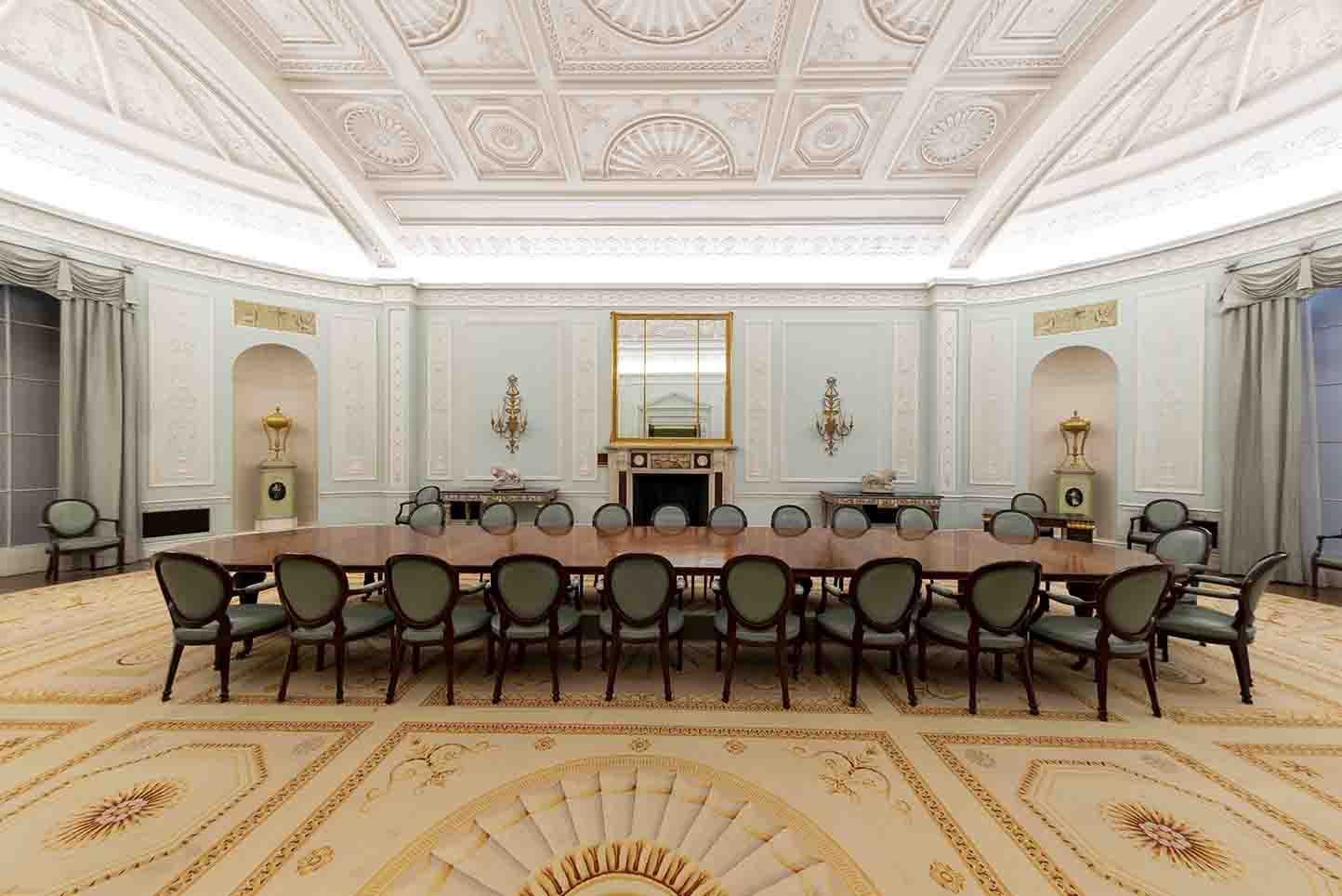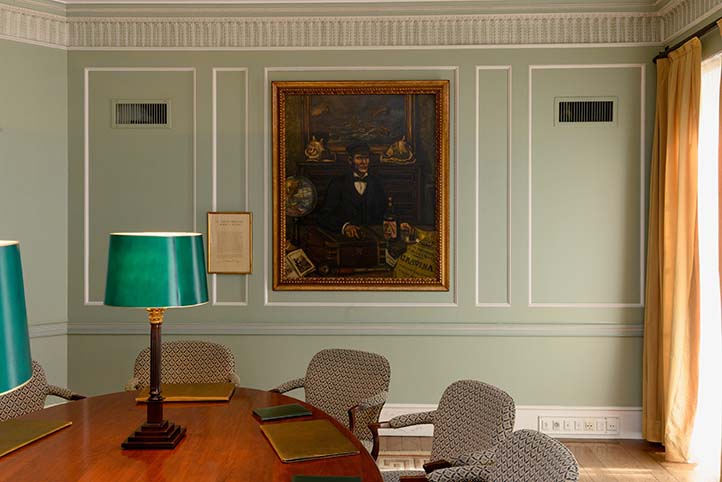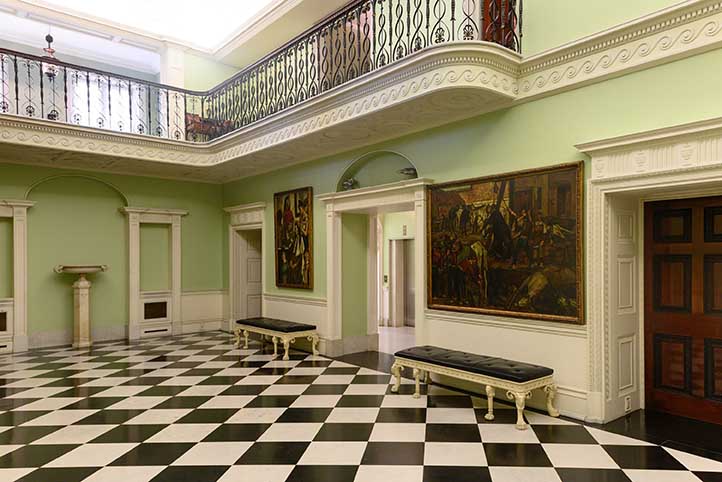Construction work process


Emptying the building
During the first four months, during the initial phase of the project, the interior of the building was completely emptied. Paintings, sculptures, decorative elements and furniture of great historical and artistic relevance have been removed to protect them from the construction process.
Removal of the carpet from the Council Room
The Adam-style piece weighs more than 700 kilograms and measures 7.50 x 14.50 metres. To remove it from the Council Room during the emptying of the building, 14 people were needed to fold, roll and pack it.
It arrived in Santander in 1962, together with the rest of the carpets that the Bank commissioned in 1958 from Miguel Stuyck, a manufacturer closely linked to the Royal Tapestry Factory in Madrid. It has adorned the Council Room ever since.
Of all the commissions, this was the most unique piece. It was woven with a density of 89,600 knots per square metre. The rest of the carpets made in the same factory were four times less dense, including those of the Royal Palace, which had 19,600 knots per square metre.
It was made as a single piece. A loom of exceptional size and hardness had to be made, using pine wood from Valsaín, in order to make it. Between 9 and 12 craftsmen were involved in its manufacture, designing the motifs of the six-colour design with exceptional realism.
This is one of the few carpets made in Spain with these characteristics that are still preserved. Both its technical specifications and the style of its design make it a piece of great historical and artistic value.


Withdrawal of pictorial work
Since its establishment as the financial headquarters, the Pereda Building has housed a number of unique works of art from the Banco Santander Collection.
These pieces have formed part of the history of the interior of the building and are almost always related to the city of Santander. Among these pieces, we find one of the first depictions of the bay, by Matthäus Merian, or a mountain landscape by the renowned Cantabrian artist Agustín de Riancho.
Above all, the most outstanding works are those by an exceptional and unique artist in the history of art: José Gutiérrez Solana. Before the building was emptied, there were nine canvases by the painter in the Pereda building, all dating from the first half of the 20th century. They are only a part of those that make up the Banco Santander Collection. The Solana collection was started by Emilio Botín Sanz de Sautuola and later expanded by his son and successor, Emilio Botín. Its original conception is undoubtedly due to the common Cantabrian origin of the painter and the Botín family, as well as to the enormous quality of the artist.
Solana was the creator of an entire plastic universe. On the walls of the Pereda meeting rooms carnival scenes, bullfighting, the lumpen of his time and female scenes were depicted. All of which were dramatic and dark, with an absolutely original and unclassifiable style.
The Banco Santander Collection currently includes 34 works by José Gutiérrez Solana, the largest collection by the artist in the world. Maria José Salazar, an expert on the artist, has analysed each of them.
Click here to view the pieces in the collection



Until it was dismantled in 2020, the Council Room was the most representative room of the Pereda building. It was decorated in the 1960s recreating the eighteenth-century Adam style, and in this room, the fireplace designed in 1774 by Giovanni Battista Piranesi (Mogliano di Mestre, 1720 - Rome, 1778) was placed as a focal piece. This architect and engraver achieved great relevance in his time. In his workshop all kinds of sculptural objects were produced, which were mainly demanded by the British aristocracy. One of the few examples of this production that has survived to the present day is precisely the fireplace in the council chamber. Made of white marble, red porphyry and alabaster, the central panel is composed of a 2nd century AD tablet with figurative decoration around the god Bacchus. Piranesi skillfully adapted all these elements to the decorative tastes of the English bourgeoisie of the 18th century.
The piece was acquired by Don Emilio Botín Sanz de Sautuola in 1958 as part of the renovation and expansion project of the institutional headquarters of Banco Santander, where it remains until the current remodeling of the Pereda building for its conversion into a cultural and leisure space. The chimney is currently on display in the historical archive of Banco Santander, together with engravings by Piranesi himself that show us the Italian's admiration for the Etruscan and Roman past.
Piranesi chimney
Until it was dismantled in 2020, the Council Room was the most representative room of the Pereda building. It was decorated in the 1960s recreating the eighteenth-century Adam style, and in this room, the fireplace designed in 1774 by Giovanni Battista Piranesi (Mogliano di Mestre, 1720 - Rome, 1778) was placed as a focal piece. This architect and engraver achieved great relevance in his time. In his workshop all kinds of sculptural objects were produced, which were mainly demanded by the British aristocracy. One of the few examples of this production that has survived to the present day is precisely the fireplace in the council chamber. Made of white marble, red porphyry and alabaster, the central panel is composed of a 2nd century AD tablet with figurative decoration around the god Bacchus. Piranesi skillfully adapted all these elements to the decorative tastes of the English bourgeoisie of the 18th century.
The piece was acquired by Don Emilio Botín Sanz de Sautuola in 1958 as part of the renovation and expansion project of the institutional headquarters of Banco Santander, where it remains until the current remodeling of the Pereda building for its conversion into a cultural and leisure space. The chimney is currently on display in the historical archive of Banco Santander, together with engravings by Piranesi himself that show us the Italian's admiration for the Etruscan and Roman past.
If you want to know more about this unique piece, click play to view video.

First stone
On May 20, the ceremony to lay the first stone of Faro Santander took place in Santander, during which Ana Botín inaugurated the works carried out on the historic building, which will soon evolve from being the financial headquarters to serving as a cultural reference site in Cantabria. The ceremony was also attended by the President of Cantabria, Miguel Ángel Revilla, and the Mayor of Santander, Gema Igual.
In her speech, the president made emotional references to her grandfather Emilio Botín-Sanz de Sautuola y López, and emphasized that this new space, by uniting culture and development, will become a place of encounter and innovation.
In order to preserve the history of this great building for future generations, a time capsule was created, into which Ana Botín inserted the following documents:
- The announcement of Banco Santander's first General Shareholders' Meeting in 1857.
- The photograph of the inauguration of the head office on Paseo de Pereda in 1923.
- The letter from Emilio Botín-Sanz de Sautuola y López to Saturnino Briz Larín, president of Banco Santander at the time, announcing his embarkation on the steamship Magallanes bound for Havana, where the bank would open its first office outside Spain (1947).
To represent the passage of time, Botín also added the daily issues of El Diario Montañés and Alerta, the video of the opening ceremony in which she visited the building for the last time before the works, and the Annual Report of the entity.
Click here for further details and images.
